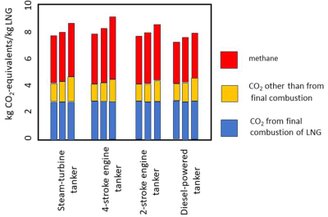Often touted as a cleaner alternative to coal, Liquefied natural gas (LNG) could have greater environmental impacts. A study published in the scientific journal Energy Science & Engineering analyzing data on LNG consumption in the United States examines the effectiveness of natural gas as a key element of the energy transition.
Climate change is a phenomenon that has been occurring since the beginning of the Earth, but it has begun to have significant effects with the increase in energy consumption of human society. This process intensified after the Industrial Revolution, when coal began to be used on a large scale to fuel furnaces and steam engines.
According to the study’s lead author, Robert Howarth, professor of ecology and environmental biology, Natural gas and shale gas are two options that are extremely harmful to the environment.. The problem lies in the fact that LNG (liquefied natural gas) is produced from shale gas using the supercooling technique, which allows it to be transported by ships to different parts of the planet.
One of the downsides of LNG is its production and distribution; This results in methane and carbon dioxide emissions along the entire production chain, from extraction to transportation.
“Overall, the greenhouse gas footprint of LNG as a fuel source is 33% greater than coal when analyzed using GWP20. It was even taken into account Within 100 years of emissions, LNG’s footprint equals or exceeds coal’s footprint, seriously underestimating methane’s climate damage”, the study explains.
Natural gas and greenhouse effect
Half of the greenhouse gas footprint of liquefied natural gas (LNG) is already produced in the stages before it is used. Research shows that LNG’s contribution to global warming has been one-third greater than coal over the last 20 years.

Over the last 100 years, researchers believe that the footprint of LNG is equal to or even greater than the footprint of coal. An example of this is that the majority of methane emissions from LNG occur during the liquefaction process, where the gas is cooled to -126 degrees Celsius to make it easier to transport on ships.
LNG is used for various purposes such as heavy vehicle fuel, electricity generation in power plants and the production of other products. Another problem is that Methane is 80 times more harmful to the atmosphere than carbon dioxide. Even so, scientists will continue to study the issue to better understand the effects of liquefied natural gas production.
“Almost all methane emissions occur upstream as we extract and liquefy shale gas. All this is being done to bring liquefied natural gas to market. So liquefied natural gas will always have a larger climate footprint than natural gas.I, whatever the assumptions about bridge fuel. “It’s still far worse than coal,” Howarth said.
Stay up to date on science and the environment at TecMundo. If you wish, take the opportunity to understand what carbon credit is and how Brazil can lead this market. Until later!
Source: Tec Mundo
I’m Blaine Morgan, an experienced journalist and writer with over 8 years of experience in the tech industry. My expertise lies in writing about technology news and trends, covering everything from cutting-edge gadgets to emerging software developments. I’ve written for several leading publications including Gadget Onus where I am an author.













